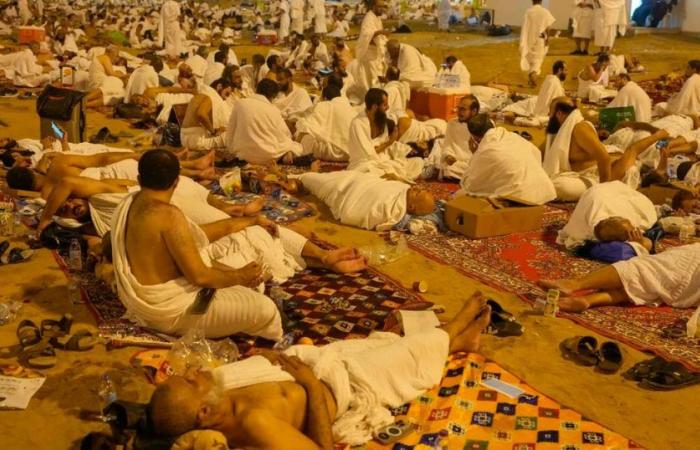At least 14 Jordanian citizens They died during the pilgrimage to Mecca due to sunstroke in the middle of a heat wavewith temperatures ranging between 45 and 48 degrees, while 17 others are missingThe Ministry of Foreign Affairs and Expatriates of Jordan reported this Sunday.
In a statement, the director of Operations and Consular Affairs, ambassador Sufyan al Qudahsaid that the ministry is following with the competent Saudi authorities the procedures for burying the pilgrims and transferring the bodies of those whose relatives wish to be transferred to Jordan as soon as possible.
Likewise, he stated that the search for the 17 missing pilgrims is still active and specified that these, as well as the deceased, were not part of the Jordanian citizens registered in the official Jordanian delegation that attended the hajj this year.
One of the challenges facing the hajj this year is the heat, since, as the authorities warned, Temperatures range between 45 and 48 degrees Celsius, with high humidity rates.
The high temperatures recorded during last year’s pilgrimage -which was attended by more than 1.8 million faithful- They caused more than 8,000 cases of fatigue and heatstroke, according to the Saudi Ministry of Health.
Furthermore, the participation of almost two million pilgrims from all over the world entails massive crowds which, in previous years, have led to stampedes in which hundreds of faithful lost their lives, as happened in 2006, when 365 people died.
In order to avoid these tragedies, Saudi Arabia promoted the use of advanced technology this year to offer a qualitative change in the organization and management of the important religious event, such as the application of intelligent robots to guide pilgrims and the installation of facial recognition cameras to improve security or locate missing persons.
Muslim pilgrims begin final Hajj rites
Masses of pilgrims embarked on a symbolic stoning of the devil in Saudi Arabia on Sunday. The ritual marks the final days of the Hajj, or Islamic pilgrimage, and the start of Eid al-Adha celebrations for Muslims around the world.
Stoning is one of the final rites of the Hajj, which is one of the Five Pillars of Islam. It came a day after more than 1.8 million pilgrims gathered on a holy hill, known as Mount Ararat, on the outskirts of the holy city of Mecca, which Muslim pilgrims visit to perform the annual five-day rituals. Hajj days.
The pilgrims left Mount Arafat on Saturday night to spend the night at a nearby site known as Muzdalifa, where they collected pebbles to use in the symbolic stoning of the pillars representing the devil.
The pillars are located in another sacred place in Mecca, called Mina, where Muslims believe that Ibrahim’s faith was tested when God ordered him to sacrifice his only son Ismail. Ibrahim was willing to submit to the order, but then God stayed his hand, sparing his son. In the Christian and Jewish versions of the story, Abraham is ordered to kill his other son, Isaac.
On Sunday morning, crowds headed on foot to the stoning areas. Some were seen pushing disabled pilgrims in wheelchairs on a multi-lane road leading to the complex housing the large pillars. Most of the pilgrims were seen suffocating and carrying umbrellas to protect themselves from the hot summer sun.
A reporter from The Associated Press He saw many pilgrims, especially elderly, collapsing on the way to the pillars due to the scorching heat. Security forces and medics were deployed to help, carrying those who fainted on stretchers to protect themselves from the heat to ambulances or field hospitals.
Many pilgrims spend up to three days in Mina, each throwing seven pebbles at three pillars in a ritual to symbolize the expulsion of evil and sin.
While in Mina, they will visit Mecca to perform their final “tawaf,” or circumambulation, which consists of circling the Kaaba at the Grand Mosque seven times counterclockwise. The Farewell Tawaf marks the end of the Hajj as pilgrims prepare to leave the holy city.
The rituals coincide with the four-day Eid al-Adha, meaning “Feast of Sacrifice,” when wealthy Muslims comment on Ibrahim’s test of faith through the sacrifice of livestock and animals and the distribution of meat. to the poor.
Most countries celebrated Eid al-Adha on Sunday, others, such as Indonesia, will celebrate it on Monday.
Once the Hajj is over, men are expected to shave their heads and remove the white garments worn during the pilgrimage, and women are expected to cut off a lock of hair as a sign of renewal and rebirth.
Most pilgrims leave Mecca for the city of Medina, about 340 kilometers (210 miles) away, to pray at the Prophet Muhammad’s tomb, the Holy Chamber. The tomb is part of the prophet’s mosque, one of the three holiest sites in Islam, along with the Great Mosque in Mecca and the Al Aqsa Mosque in Jerusalem.
All Muslims are obliged to perform Hajj once in their lifetime if they are physically and financially capable of doing so. Many wealthy Muslims make the pilgrimage more than once. The rituals largely commemorate the stories of the Prophet Ibrahim and his son, the Prophet Ismail, Ismail’s mother, Hajar, and the Prophet Muhammad, according to the Quran, the holy book of Islam.
More than 1.83 million Muslims performed the Hajj in 2024, Saudi Hajj and Umrah Minister Tawfiq bin Fawzan al-Rabiah said in a briefing, slightly less than last year’s figures, when 1.84 million They performed the rituals.
Most Hajj rituals take place outdoors with little or no shade. It is set for the second week of Dhu al-Hijjah, the last month of the Islamic lunar calendar, so its time of year varies. And this year the pilgrimage fell in the burning summer of Saudi Arabia. The heat rose to 47°C (116.6°F) on Mount Arafat on Saturday.
This year’s Hajj took place against the backdrop of the devastating war between Israel and Hamas, which has brought the Middle East to the brink of regional conflict.
Palestinians in the Gaza Strip were unable to travel to Mecca for the Hajj this year due to the closure of the Rafah crossing in May, when Israel extended its ground offensive to the city on the border with Egypt. And they will not be able to celebrate Eid al-Adha as they used to do in previous years.
Dozens of Palestinians gathered near a destroyed mosque in the southern Gaza town of Khan Younis on Sunday morning to perform Eid prayers.. In the nearby city of Deir al-Balah in central Gaza, Muslims held prayers in a school converted into a shelter. Some, including women and children, went to cemeteries to visit the graves of their loved ones.
“Today, after the ninth month, more than 37,000 martyrs, more than 87,000 wounded and hundreds of thousands of homes were destroyed,” Abdulhalim Abu Samra, a displaced Palestinian, told the AP after concluding prayers in Khan Younis. “Our people live in difficult circumstances.”
There is also the conflict between rival generals in Sudan that has raged unabated for 14 months. The conflict killed thousands of people and created the world’s largest displacement crisis, with more than 10 million people forced to flee their homes.
(With information from EFE and AP)






